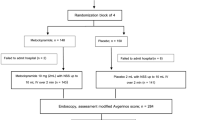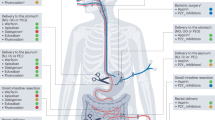Abstract
Peptic ulcer bleeding is a common and potentially fatal condition. It is best managed using a multidisciplinary approach by a team with medical, endoscopic and surgical expertise. The management of peptic ulcer bleeding has been revolutionized in the past two decades with the advent of effective endoscopic hemostasis and potent acid-suppressing agents. A prompt initial clinical and endoscopic assessment should allow patients to be triaged effectively into those who require active therapy, versus those who require monitoring and preventative therapy. A combination of pharmacologic and endoscopic therapy (using a combination of injection and thermal coagulation) offers the best chance of hemostasis for those with active bleeding ulcers. Surgery, being the most effective way to control bleeding, should be considered for treatment failures. The choice between surgery and repeat endoscopic therapy should be based on the pre-existing comorbidities of the patient and the characteristics of the ulcer.
Key Points
-
Peptic ulcer bleeding is a common and potentially fatal condition that occurs predominantly in the elderly
-
Early risk stratification based on clinical and endoscopic criteria facilitates the delivery of the appropriate level of care to patients with peptic ulcer bleeding
-
Combining pharmacologic and endoscopic therapy offers the best chance of hemostasis for patients with active bleeding ulcers
-
Patients with an adherent clot and a protuberant vessel should probably receive the same therapy as those with actively bleeding ulcers
-
Rebleeding can be handled effectively by repeat endoscopic therapy or surgery: which to use should be based on the pre-existing comorbidities of the patient
This is a preview of subscription content, access via your institution
Access options
Subscribe to this journal
Receive 12 print issues and online access
$209.00 per year
only $17.42 per issue
Buy this article
- Purchase on Springer Link
- Instant access to full article PDF
Prices may be subject to local taxes which are calculated during checkout

Similar content being viewed by others
References
Yavorski RT et al. (1995) Analysis of 3294 cases of upper gastrointestinal bleeding in military medical facilities. Am J Gastroenterol 90: 568–573
Longstreth GF (1995) Epidemiology of hospitalization for acute upper gastrointestinal hemorrhage: a population-based study. Am J Gastroenterol 90: 206–210
Rockall TA et al. (1995). Incidence of and mortality from acute upper gastrointestinal haemorrhage in the United Kingdom. Steering committee and members of the National Audit of Acute Upper Gastrointestinal Haemorrhage. BMJ 38: 222–226
Rockall TA et al. (1996) Risk assessment after upper gastrointestinal haemorrhage. Gut 38: 316–321
Vreeburg EM et al. (1999) Validation of the Rockall risk scoring system in upper gastrointestinal bleeding. Gut 44: 331–335
Church NI and Palmer KR (2001) Relevance of the Rockall score in patients undergoing endoscopic therapy for peptic ulcer haemorrhage. Eur J Gastroenterol Hepatol 13: 1149–1152
Sanders DS et al. (2002) Prospective validation of the Rockall risk scoring system for upper GI hemorrhage in subgroups of patients with varices and peptic ulcers. Am J Gastroenterol 97: 630–635
Blatchford O et al. (2000) A risk score to predict need for treatment for upper-gastrointestinal haemorrhage. Lancet 356: 1318–1321
Saeed ZA et al. (1995) Prospective validation of the Baylor bleeding score for predicting the likelihood of rebleeding after endoscopic hemostasis of peptic ulcers. Gastrointest Endosc 41: 561–565
Barkun A et al. (2003) Consensus recommendations for managing patients with nonvariceal upper gastrointestinal bleeding. Ann Intern Med 139: 843–857
Green FW et al. (1978) Effect of acid and pepsin on blood coagulation and platelet aggregation. Gastroenterology 74: 38–43
Levine JE et al. (2002) Meta-analysis: the efficacy of intravenous H2-receptor antagonists in bleeding peptic ulcer. Aliment Pharmacol Ther 16(6): 1137–1142
Collins R and Langman M (1985) Treatment with histamine H2 antagonists in acute upper gastrointestinal hemorrhage. N Engl J Med 131: 660–666
Daneshmend TK et al. (1992) Omeprazole versus placebo for acute upper gastrointestinal bleeding: randomized double-blind controlled trial. Br Med J 304: 143–147
Schaffalitzky de Muckadell OB et al. (1997) Effect of omeprazole on the outcome of endoscopically treated bleeding peptic ulcers: randomized double-blind placebo-controlled multicentre study. Scand J Gastroenterol 32: 320–327
Hasselgren G et al. (1997) Continuous intravenous infusion of omeprazole in elderly patients with peptic ulcer bleeding: results of a placebo-controlled multicenter study. Scand J Gastroenterol 32: 328–333
Khuroo MS et al. (1997) A comparison of omeprazole and placebo for bleeding peptic ulcer. N Engl J Med 336: 1054–1058
Lau JY et al. (2000) Effect of intravenous omeprazole on recurrent bleeding after endoscopic treatment of bleeding peptic ulcers. N Engl J Med 343: 310–316
Javid G et al. (2001) Omeprazole as adjuvant therapy to endoscopic combination injection sclerotherapy for treating bleeding peptic ulcer. Am J Med 111: 280–284
Kaviani MJ et al. (2003) Effect of oral omeprazole in reducing re-bleeding in bleeding peptic ulcers: a prospective, double–blind, randomized, clinical trial. Aliment Pharmacol Ther 17: 211–216
Leontiadis GI et al. (2004) Proton pump inhibitor treatment for acute peptic ulcer bleeding. The Cochrane Database of Systematic Reviews, Issue 3, Art. No CD002094
Barkun A et al. (2004) Prevention of peptic ulcer rebleeding using continuous infusion of pantoprazole vs ranitidine: a multicenter, multinational, randomized, double-blind, parallel group comparison [abstract]. Gastroenterol 126 (Suppl 4): A78
ASGE Guideline (2004) The role of endoscopy in upper gastrointestinal bleeding. Gastrointest Endosc 60: 497–504
Lau JYW et al. (2005) Early administration of high-dose intravenous omeprazole prior to endoscopy in patients with upper gastrointestinal bleeding: a double-blind placebo controlled randomized trial [abstract]. Gastroenterol 128 (Suppl 2): A50
Cheng HC et al. (2005) The efficacy of high- and low-dose intravenous omeprazole in preventing rebleeding for patients with bleeding peptic ulcers and comorbid illnesses. Dig Dis Sci 50: 1194–1201
Udd M et al. (2001) Regular-dose versus high-dose omeprazole in peptic ulcer bleeding: a prospective randomized double-blind study. Scand J Gastroenterol 36: 1332–1338
Sacks HS et al. (1990) Endoscopic hemostasis: an effective therapy for bleeding peptic ulcers. JAMA 264: 494–499
Cook DJ et al. (1992) Endoscopic therapy for acute non-variceal upper gastrointestinal hemorrhage—a meta-analysis. Gastroenterology 102: 139–148
Park CH et al. (2004) Optimal injection volume of epinephrine for endoscopic prevention of recurrent peptic ulcer bleeding. Gastrointest Endosc 60: 875–880
Chau CH et al. (2003) Randomized controlled trial comparing epinephrine injection plus heat probe coagulation versus epinephrine injection plus argon plasma coagulation for bleeding peptic ulcers. Gastrointest Endosc 57: 455–461
Cipolletta L et al. (2001) Endoclips versus heater probe in preventing early recurrent bleeding from peptic ulcer: a prospective and randomized trial. Gastrointest Endosc 53: 147–151
Lin HJ et al. (2002) A prospective, randomized trial of endoscopic hemoclip versus heater probe thermocoagulation for peptic ulcer bleeding. Am J Gastroenterol 97: 2250–2254
Gevers AM et al. (2002) A randomized trial comparing injection therapy with hemoclip and with injection combined with hemoclip for bleeding ulcers. Gastrointest Endosc 55: 466–469
Chung SCS et al. (1997) Randomized comparison between adrenaline injection alone and adrenaline injection plus heat probe treatment for actively bleeding ulcers. Br Med J 314: 1307–1311
Calvet X et al. (2004) Addition of a second endoscopic treatment following epinephrine injection improves outcome in high-risk bleeding ulcers. Gastroenterology 126: 441–450
Marmo R et al. (2003) Outcome of endoscopic treatment for peptic ulcer bleeding: is a second look necessary? A meta-analysis. Gastrointest Endosc 57: 62–67
Chiu PW et al. (2003) Effect of scheduled second therapeutic endoscopy on peptic ulcer rebleeding: a prospective randomised trial. Gut 52: 1403–1407
Jensen DM et al. (2002) Randomized trial of medical or medical therapy to prevent recurrent ulcer hemorrhage in patients with adherent clots. Gastroenterology 123: 407–413
Bleau BL et al. (2002) Recurrent bleeding from peptic ulcer associated with adherent clot: a randomized study comparing endoscopic treatment with medical therapy. Gastrointest Endosc 56: 1–6
Sung JJY et al. (2003) The effect of endoscopic therapy in patients receiving omeprazole for bleeding ulcers with non-bleeding visible vessels or adherent clots: a randomized comparison. Ann Intern Med 139: 237–243
Lau JYW et al. (1999) Endoscopic retreatment compared with surgery in patients with recurrent bleeding after initial endoscopic control of bleeding ulcers. N Engl J Med 340: 751–756
Graham DY et al. (1993) Treatment of Helicobacter pylori reduces the rate of rebleeding in peptic ulcer disease. Scand J Gastroenterol 28: 939–942
Sung JJY et al. (1997) One-week antibiotics versus maintenance acid suppression therapy for Helicobacter pylori-associated peptic ulcer bleeding. Dig Dis Sci 42: 2524–2528
Lai KC et al. (2000) Treatment of Helicobacter pylori in patients with duodenal ulcer hemorrhage—a long-term randomized, controlled study. Am J Gastroenterol 95: 2225–2232
Author information
Authors and Affiliations
Corresponding author
Ethics declarations
Competing interests
The author declares no competing financial interests.
Rights and permissions
About this article
Cite this article
Sung, J. Current management of peptic ulcer bleeding. Nat Rev Gastroenterol Hepatol 3, 24–32 (2006). https://doi.org/10.1038/ncpgasthep0388
Received:
Accepted:
Issue Date:
DOI: https://doi.org/10.1038/ncpgasthep0388
This article is cited by
-
Intravenous Esomeprazole for Prevention of Peptic Ulcer Rebleeding: A Randomized Trial in Chinese Patients
Advances in Therapy (2015)
-
Effect of Comorbidity on Mortality in Patients With Peptic Ulcer Bleeding: Systematic Review and Meta-Analysis
American Journal of Gastroenterology (2013)
-
Therapeutic and interventional endoscopy for gastrointestinal bleeding
European Journal of Trauma and Emergency Surgery (2011)
-
Management der Ulkusblutung
Der Internist (2006)



